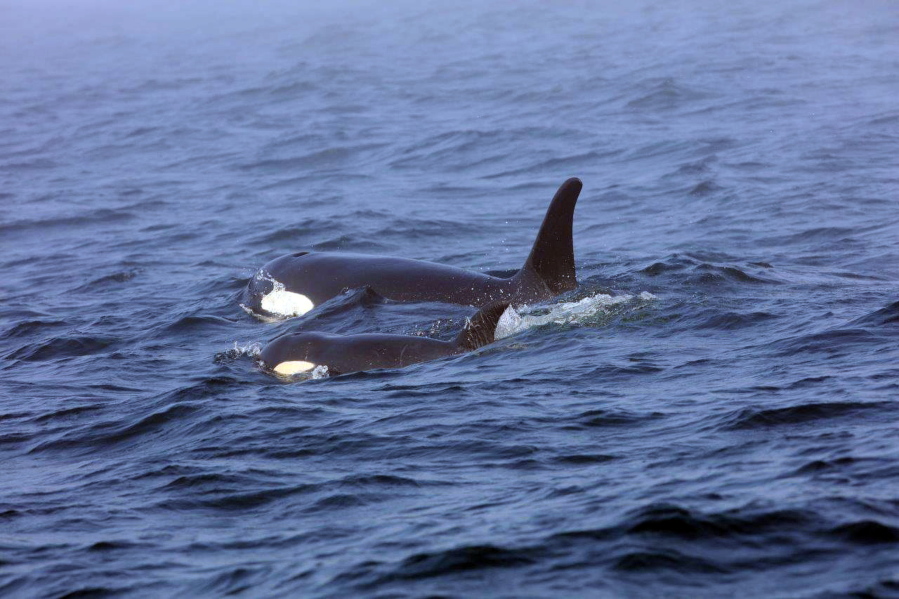The emergency effort to save a critically ill orca whale is an experiment without precedent.
An international team of scientists is piloting techniques to treat a wild, free-swimming orca, one of the largest predators on Earth. The effort includes serving up live fish pumped with medicine and playing a unique tone that one researcher likened to a “dinner bell.”
A federal permit approved Aug. 8 provides the clearest look yet at the details of an operation that raises questions even for those involved about the proper limits of human intervention.
“It’s constantly a topic in our minds and in our conversations, ‘Are we doing more harm than good?'” said Sarah Wilkin. She is a national stranding- and emergency-response coordinator based in Silver Spring, Md., for the National Oceanic and Atmospheric Administration, which is leading the rescue.
The operation in the Washington waters of the Salish Sea could change — or even be discontinued — depending on J50’s condition, and how she and her family respond to intervention.
The effort to save J50 was devised as the plight of critically endangered southern resident killer whales was pushed into the world spotlight by Tahlequah, or J35, one of J50’s relatives. Tahlequah gave birth on July 24 to a female calf that lived only half an hour. She clung to the calf, swimming more than 1,000 miles for at least 17 days, refusing to let her baby go. The sight of her bearing her sad burden day after day moved people around the world.
The whales are a signature of Puget Sound, the transboundary waters of the Salish Sea, and even the outer coast, where the orcas forage for salmon nearly as far south as San Francisco.
With only 75 whales left in the southern resident population, which is unique in the world, an international team of experts is working to prevent the loss of another member of the family.
Always small for her age, J50, at 3 1/2 years old, is now so thin the bones of her head show; most orcas that skinny have died. Scientists fear she may not have long to live.
The team assembled to devise and execute the plan includes veterinarians and biologists from SeaWorld, the Vancouver Aquarium, the U.S. Navy, various nonprofits and NOAA.
Partners in the effort include the Washington Department of Fish and Wildlife — which is providing hatchery chinook to be served to J50 alive and swimming — and the Lummi Nation. The tribe is delivering the salmon using its law-enforcement boat, carrying the fish from a dock in Bellingham to wherever in Washington waters J50 can be located — and fed.
A complex operation
The permit governing the operation outlines a complex approach to a difficult problem. How to feed and medicate a wild whale — without doing more harm than good.
While J50 has been shot with a dart once to deliver a dose of antibiotics, scientists think she may be suffering from an infection, possibly fungal pneumonia. Antifungal medications and worming medication to tackle internal parasites can only be given by mouth.
Lab results from fecal material collected from J50s family show the presence of intestinal worms. While it is not known if the fecal material came specifically from her, scientists are adding a wormer to her medications.
The worm is not usually a problem in healthy animals. But in animals that are emaciated or otherwise compromised, the parasite can penetrate the stomach lining, introducing bacterial infection to the bloodstream, or bore into internal organs, NOAA announced Friday night in a posting on its online update page for J50.
The medications are intended to help J50 get on with gaining weight and a return to health. Salmon are being provided to J50 primarily as a delivery for medication, Wilkin said.
“Everyone has been very clear they don’t want to embark on some kind of longterm feeding program for the purpose of feeding,” Wilkin said. But J50 has lost about 20 percent of her body weight and also needs hydration. Orcas get all their hydration from fish, which is 70 percent water.
To see if she eats the fish, the operation will be photographed by a drone overhead and observed by scientists on a second boat at close range as the fish are sluiced through a plastic tube from the back of the Lummi boat. The tube’s exit is below the surface of the water.
A fish scale will be taken off the salmon before it is fed to J50; DNA analysis will match it with any fish scales captured floating on the water. That’s if she eats. J50 took no visible notice of the fish when eight were fed to her on a first trial Aug. 13.
Special care is being taken to avoid J50 learning to associate boats with being fed, or with a particular person feeding her fish.
A device to play a unique tone, specially manufactured for the operation, can be played underwater as fish are fed, so she will associate the tone — and only the tone — with the fish. “Almost like … a dinner bell,” said Jeff Foster, a biologist involved in the feeding operation.
The last thing the biologists want is to teach orcas to start soliciting fish from boats, Foster said. The idea is that if only the tone means fish, the sound of a boat — without the tone — should not.



